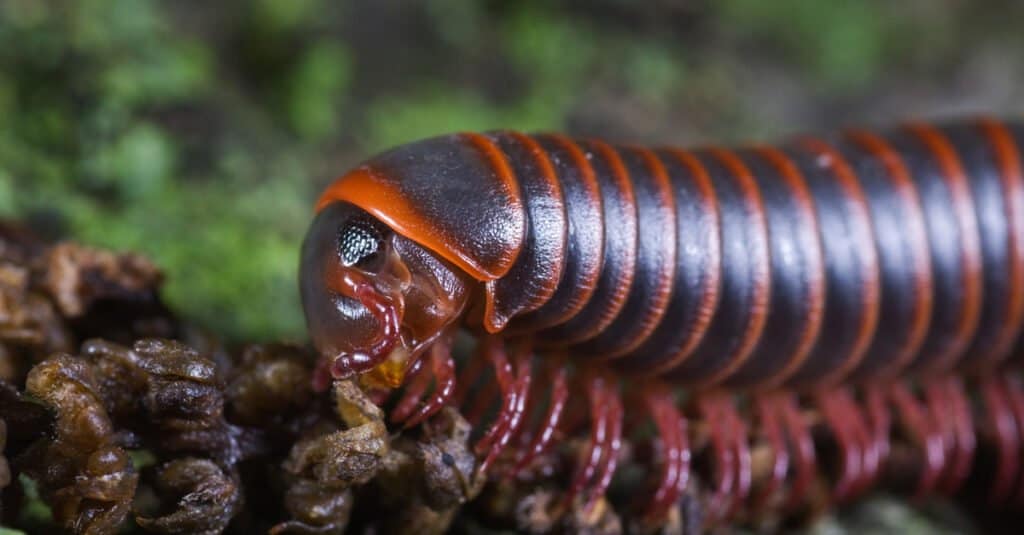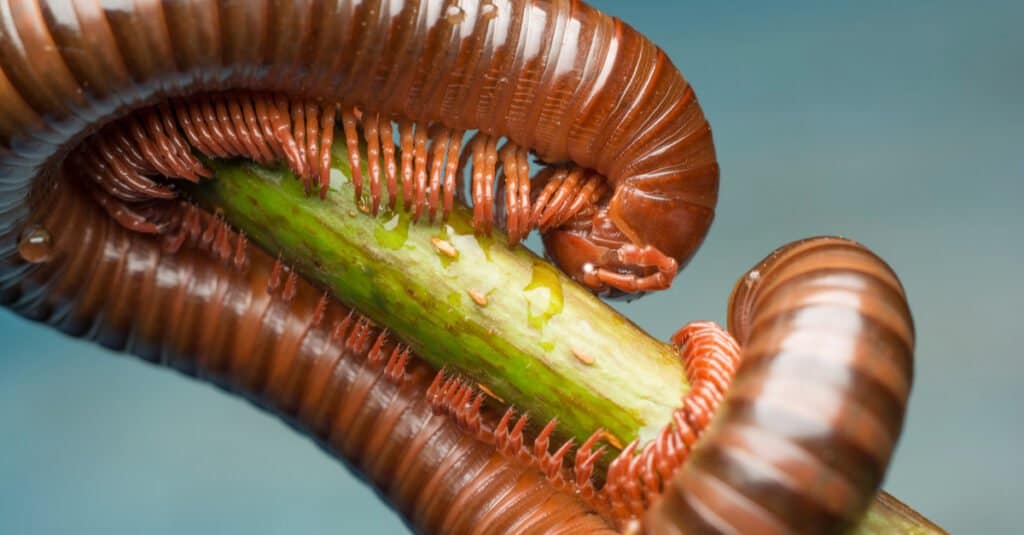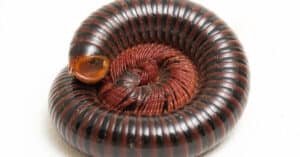How Many Legs Does a Millipede Have?
Millipedes are insects known for their large number of legs. Just how many legs do these arthropods have? Some may think that they have 1,000 legs, but no species of millipede have been discovered with this many legs. There are around 12,000 species of millipede, divided into 16 orders and 140 families. With such a large variety some species are bound to differ.
Millipedes have some of the most legs in the animal kingdom. Similar to centipedes but not quite the same. Millipedes have four legs per segment, while centipedes only have two. The number of legs a millipede will have varies, depending on the species. While they may look similar, millipedes are not insects. Insects only have 6 legs, while millipedes can have hundreds. Millipedes are in the subphylum of Myriapoda but are anthropoids like insects.
How Many Legs Do Millipedes Have

Gerry Bishop/Shutterstock.com
The number of legs a millipede will have varies and is dependent on the species. Millipedes have two pairs of legs per segment, and the number of segments per species is around 25 to 100. Most species of millipede will have 300 legs, sometimes a bit more. The millipede species found with the most legs is Illacme plenipes, which is recorded to have had up to 750 legs.
The Millipede Species With The Most Legs: Illacme plenipes
Illacme plenipes is a species of millipede that has the most legs, and comes the closest to reaching the 1000 leg milestone. On average they have around 600 legs but like other millipede species, their leg count will vary. The average leg count of this species is twice the average of other millipede leg counts. They were first seen in 1926 but were never found again. It took another 80 years before the species would be rediscovered.
This species belongs to the genus Illacme, and the only other species in that genus is illacme tobini. Even though they have more legs than other species their size is relatively small compared to other millipedes. A millipede’s leg count will depend on the number of segments, not its body length. Illacme plenipes only grow to around 3 cm, and has a pale yellow color.
This species was first found in California, near San Bernardino. In the U.S and Canada, there are around 1,400 different species of millipedes. New millipede species are always being discovered and give hope that one day a species will be found that has 1,000 legs.
Why Do Millipedes Have So Many Legs

Piyapong pc/Shutterstock.com
Millipede legs are interesting and give the animal a unique look, but also give them plenty of advantages. Millipedes are terrestrial and live their life by feeding on dead leaves and decaying matter. The legs help them traverse and move around a floor littered with natural debris. The soil’s dense habitat would be harder to get around if the millepede did not have many legs.
Millipedes travel on top of the soil, but will also burrow underneath it. Their legs help them push their body through the dirt or gain leverage when going into tight spaces. The many legs of a millipede make it one of the most effective travelers on the forest floor.
Millipedes are born with just a few legs and will gain more as they age. When they shed their exoskeletons they replace it with a new one, a process called molting. After each molting period they are given a new segment, thus another pair of two legs. Centipedes also have this process, but only gain two legs per segment. This means the number of legs a millipede has will depend on its species type, and also its age. Some stop molting while others go through the process their whole lives, but only live for a short period.
FAQs (Frequently Asked Questions)
Are millipedes insects?
Millipedes are not insects but do belong to the phylum of arthropods. This phylum includes insects, crustaceans, arachnids, and the subphylum of myriapods. Millipedes are myriapods that have over 13,000 species of discovered animals, most of which are centipedes and millipedes.
Is it safe to pick up millipedes?
Millipedes do not bite, but you should still be wary when picking one up. Most species have glands that emit an irritant. This fluid will smell and can cause an allergic reaction. They only do this when frightened, so they can be handled when calm.
What is the difference between a Pill Bug (Roly Poly) and Pill Millipede?
Pillbugs (Oniscidea) and pill millipedes (Oniscomorpha)are quite similar, but only the pill millipede is classified as a myriapod. Pillbugs look extremely similar to a tiny millipede but they are actually crustaceans. The similarities between these two species are an example of convergent evolution.
Can humans eat millipedes?
Millipedes cannot be eaten because most species are poisonous if consumed. They do have natural predators like toads, birds, ants, and beetles. In Africa, the Bobo tribe is one society where eating millipedes is common. The toxic secretion of millipede species is a reason why this practice is not more widespread, but they can prepare the millipede and eat it safely.
Can Millipedes Make Good Pets?
Millipedes are fairly low-maintenance pets. The giant millipede species are some of the largest and are the easiest for beginners to keep. They require minimal upkeep and less work when compared with something like a dog, cat, or bird. All you need is a terrarium designed to mimic their habitat to keep them. Feeding them regularly and maintaining their environment can give them a long healthy life.
More from A-Z Animals
Millipedes are insects known for their large number of legs. Just how many legs do these arthropods have? Some may think that they have 1,000 legs, but no species of millipede have been discovered with this many legs. There are around 12,000 species of millipede, divided into 16 orders and 140 families. With such a large variety some species are bound to differ.
Millipedes have some of the most legs in the animal kingdom. Similar to centipedes but not quite the same. Millipedes have four legs per segment, while centipedes only have two. The number of legs a millipede will have varies, depending on the species. While they may look similar, millipedes are not insects. Insects only have 6 legs, while millipedes can have hundreds. Millipedes are in the subphylum of Myriapoda but are anthropoids like insects.
How Many Legs Do Millipedes Have

Gerry Bishop/Shutterstock.com
The number of legs a millipede will have varies and is dependent on the species. Millipedes have two pairs of legs per segment, and the number of segments per species is around 25 to 100. Most species of millipede will have 300 legs, sometimes a bit more. The millipede species found with the most legs is Illacme plenipes, which is recorded to have had up to 750 legs.
The Millipede Species With The Most Legs: Illacme plenipes
Illacme plenipes is a species of millipede that has the most legs, and comes the closest to reaching the 1000 leg milestone. On average they have around 600 legs but like other millipede species, their leg count will vary. The average leg count of this species is twice the average of other millipede leg counts. They were first seen in 1926 but were never found again. It took another 80 years before the species would be rediscovered.
This species belongs to the genus Illacme, and the only other species in that genus is illacme tobini. Even though they have more legs than other species their size is relatively small compared to other millipedes. A millipede’s leg count will depend on the number of segments, not its body length. Illacme plenipes only grow to around 3 cm, and has a pale yellow color.
This species was first found in California, near San Bernardino. In the U.S and Canada, there are around 1,400 different species of millipedes. New millipede species are always being discovered and give hope that one day a species will be found that has 1,000 legs.
Why Do Millipedes Have So Many Legs

Piyapong pc/Shutterstock.com
Millipede legs are interesting and give the animal a unique look, but also give them plenty of advantages. Millipedes are terrestrial and live their life by feeding on dead leaves and decaying matter. The legs help them traverse and move around a floor littered with natural debris. The soil’s dense habitat would be harder to get around if the millepede did not have many legs.
Millipedes travel on top of the soil, but will also burrow underneath it. Their legs help them push their body through the dirt or gain leverage when going into tight spaces. The many legs of a millipede make it one of the most effective travelers on the forest floor.
Millipedes are born with just a few legs and will gain more as they age. When they shed their exoskeletons they replace it with a new one, a process called molting. After each molting period they are given a new segment, thus another pair of two legs. Centipedes also have this process, but only gain two legs per segment. This means the number of legs a millipede has will depend on its species type, and also its age. Some stop molting while others go through the process their whole lives, but only live for a short period.





